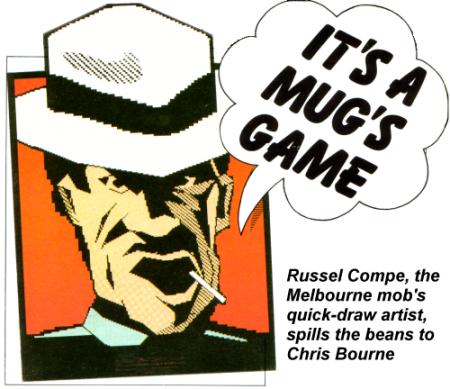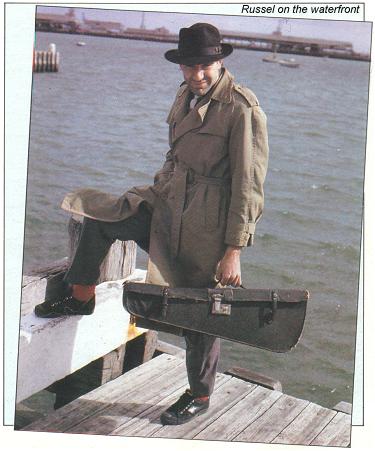| Hit Squad |

MONDAY MORNING. I sat in my office, waiting for a call. A call from the other side of the world, from Melbourne, Australia. A call from a dingy milk bar off Collins Street, from a man I didn't know.
"Talk to him" said the boss. "Get his story." I wasn't sure I wanted to know the story, a story from a city where the sharks in the harbour dine twice weekly on stoolpigeon pie, where good citizens lock themselves in on a Saturday night with a crate of West End and watch old Movies. "Who is he?" I asked. The boss looked around, and lowered his voice. "Russel Compe" he rasped. "The man who drew the pix for ... Mugsy".
Mugsy! The name flashed through my brain like a shot of Polish vodka. The story of simple, spaghetti-loving Sicilians which would have been the flop of the year without Russel Compe. Compe, the graphics guy who transformed an ordinary text-only 'land management' game into a smash hit with his atmospheric cartoon pictures and animated sequences.
The phone rang. I picked it up. We talked.
Who was he working for these days? Melbourne House. It figured. Based in Australia, with its major marketing and distribution centres in London and New York, the programmers and designers all worked in Melbourne, Victoria. "How d'ya stay wise to the action?" I asked. "That's a long ways away."
"We can still keep in touch" said Russel. "As long as you believe in what you do, there's little difference. Everyone here is pretty well versed in what's going on."
As we talked, I found out more. His people emigrated to Australia in the last century, to the area around Bendigo in Victoria, where Russel was born.
"What can I say about Bendigo? Born on the gold rush. It's very much a provincial city, with 50,000 people. The buildings are stately - it's a nice sort of city."
His great-grandparents, who were French, came for the gold, and stayed. Russel was schooled there, and took a course in graphic design at the local college. There was never any doubt about his artistic leanings - the kid loved paint.
"From about the age of five I was always playing with pens and paper. When I was older I was thinking about architecture, but at college I wanted to be an artist. An artist has no limits but a smaller audience - when you're a painter, you paint for yourself."
He told me he dropped the notion. The other cats were too self-indulgent, he said. I had to put the phone down to look the word up.
"The obvious thing was to work for advertising agencies and design studios, but there wasn't a great deal of work." The break came a year ago, when Melbourne House advertised for a graphic designer, and hired Russel. Before he got the fix for Mugsy, he worked on Melbourne Draw and HURG - whatever that was. His boss has faith in his own products - Russel said he used Melbourne Draw to develop the graphics for other programs.
"So tell me, Russel" I asked. "How d'ya do them fancy pictures and all that?" There was a pause on the other end of the line. For a moment, I thought I'd said something wrong.

"When I was first here they weren't sure what was needed" he said. "Now we have draw and fill, stipple effects - it all saves space."
It also meant he could work on programs directly - he said he couldn't write a program himself, not even in Basic. Who can, for gossakes? But he seemed to like it that way. "I'm not sure what I can and can't do. If you don't know the limits you are always exploring."
I didn't know what he was talking about but he seemed pleasant enough. Time for the big one. How did he get involved in the Mugsy racket?
"The actual script was the only brief I got" he said. "When we saw it it seemed to lend itself to a comic book format, with a different treatment for each frame."
Comics I understood. Read them myself. Apparently Russel was a fan too. "What's your favourite?"' I asked. He said he liked The Spirit, by, Will Eisner, a comic with gangster stories which had a big influence on Mugsy.
"There's a great similarity between comic and computer art. I don't think people were aware of the potential of computer graphics at first. I like good strong colour in the comic style with contrasts in black and white."
First he had to work out how many pix he could fit into the game. "With the scenes of people talking it was pretty much up to me what I did" he said. "I got pretty involved with recognising cityscapes and waterfront scenes from gangster movies. I tried to see unusual angles and move the scenes outside."
His favourite was the aerial view of two gangsters in a dark street. Maybe you thought those scenes were displayed at random. That is true only when things go well for you. When the heat is on, your henchman Louie will be seen looking kind of pained.
This guy Russel, he made it sound so easy. Even the animation. "We didn't need too much detail but it had to be related to what was going on in the game. The purpose was to set a mood, especially with the speakeasy scene." Speed was the main thing, according to Russel. Getting it right. He said he used a pixel scroll on the limo, the only actual animation was for the wheels. But the overall effect looked real.
The Melbourne mob moved to the south side of town a few months back, and Russel said he liked the city. "It's bigger, there's more to see and do. I'm a city boy, I like the lights and noise." I made some dumb crack about Fosters lager. "I'm a whisky man" he growled. He kept himself in shape, too. played basketball Monday nights for a local team.
I poured another slug of Jack Daniels and lit up a Woodbine - my twentieth of the morning. "What's the buzz on the vine, then Russel? Who are the mob going to hit next?"
He said he'd just finished working over Sherlock Holmes, the English shamus with the weird headgear. "A lot of the game is taken up by the logic and text, so the graphics are simpler. We used reference books from the period - Victorian London."
I sweated at the thought of Mugsy's hoods loose in London. But Russel's part in that was over now. His latest operation was Sports Hero inspired by the Olympics. He said it would be similar to the arcade game Hyper Olympics but with three levels - you will have to qualify for the games proper. The graphics were to be large, with eight-stage animation. Sounded like a dame I knew in Birmingham. "I'm pretty happy with them, both the screen-scrolling and the animations" he said. "There should be some interesting games around by Christmas."
He told me you needed a different approach to arcade games from adventures. With adventures, the pictures are only limited by the size of the memory and the story line. Arcade games require that the graphics be an integral part of the structure. "In that case we'll be told what the game's about, what the size limits are, and so on. Animation can be very limited - there was not a lot in Penetrator."
He used to spend hours in the arcades, he said, feeding the slots with quarters. After the mob took over, he leaned towards the adventure racket - not surprising, since Melbourne House was the gang who sicked The Hobbit on an unsuspecting world. "Don't you feel bad" I asked, "Giving up on architecture and painting for the old software scam?"
"I don't feel at all limited. There's always some new trick to learn. Look at the things we can do now, compared to when I started. The biggest problem is working with character squares and straight lines. But you can get fairly close using Melbourne Draw. There's a formality about it - it's certainly not like using canvas."
I wanted to talk about Russel's interest in computer-generated art, about his favourite games and his taste in broads. But 12,000 miles away the sun was setting, the pimps and hustlers crawling out of the seamy bars, the coarse stutter of machine guns beginning to play in counterpoint to the sirens of the squad cars. The line went dead. Good luck, Russel. Hope you make it.